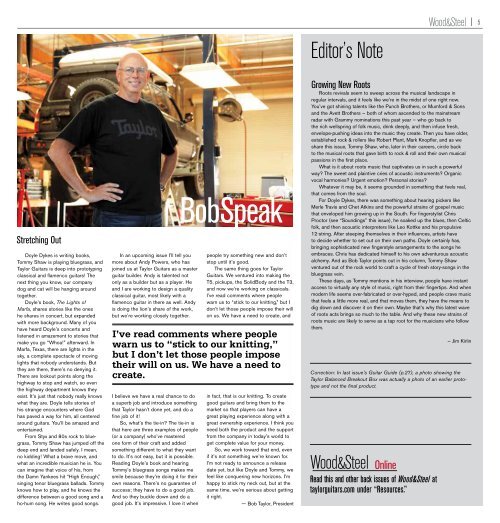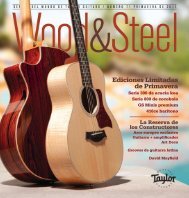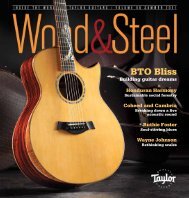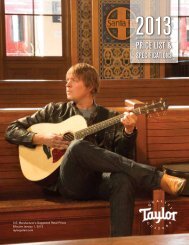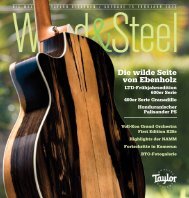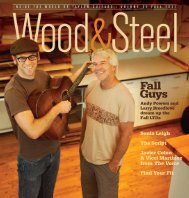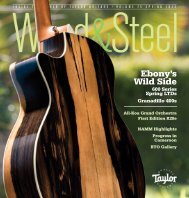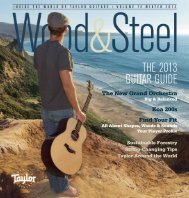Create successful ePaper yourself
Turn your PDF publications into a flip-book with our unique Google optimized e-Paper software.
5<br />
Editor’s Note<br />
Stretching Out<br />
Doyle Dykes is writing books,<br />
<strong>Tommy</strong> <strong>Shaw</strong> is playing bluegrass, and<br />
<strong>Taylor</strong> <strong>Guitars</strong> is deep into prototyping<br />
classical and flamenco guitars! The<br />
next thing you know, our company<br />
dog and cat will be hanging around<br />
together.<br />
Doyle’s book, The Lights of<br />
Marfa, shares stories like the ones<br />
he shares in concert, but expanded<br />
with more background. Many of you<br />
have heard Doyle’s concerts and<br />
listened in amazement to stories that<br />
make you go “Whoa!” afterward. In<br />
Marfa, Texas, there are lights in the<br />
sky, a complete spectacle of moving<br />
lights that nobody understands. But<br />
they are there, there’s no denying it.<br />
There are lookout points along the<br />
highway to stop and watch, so even<br />
the highway department knows they<br />
exist. It’s just that nobody really knows<br />
what they are. Doyle tells stories of<br />
his strange encounters where God<br />
has paved a way for him, all centered<br />
around guitars. You’ll be amazed and<br />
entertained.<br />
From Styx and 80s rock to bluegrass,<br />
<strong>Tommy</strong> <strong>Shaw</strong> has jumped off the<br />
deep end and landed safely. I mean,<br />
no kidding! What a brave move, and<br />
what an incredible musician he is. You<br />
can imagine that voice of his, from<br />
the Damn Yankees hit “High Enough,”<br />
singing tenor bluegrass ballads. <strong>Tommy</strong><br />
knows how to play, and he knows the<br />
difference between a good song and a<br />
ho-hum song. He writes good songs.<br />
In an upcoming issue I’ll tell you<br />
more about Andy Powers, who has<br />
joined us at <strong>Taylor</strong> <strong>Guitars</strong> as a master<br />
guitar builder. Andy is talented not<br />
only as a builder but as a player. He<br />
and I are working to design a quality<br />
classical guitar, most likely with a<br />
flamenco guitar in there as well. Andy<br />
is doing the lion’s share of the work,<br />
but we’re working closely together.<br />
I believe we have a real chance to do<br />
a superb job and introduce something<br />
that <strong>Taylor</strong> hasn’t done yet, and do a<br />
fine job of it!<br />
So, what’s the tie-in? The tie-in is<br />
that here are three examples of people<br />
(or a company) who’ve mastered<br />
one form of their craft and added<br />
something different to what they want<br />
to do. It’s not easy, but it is possible.<br />
Reading Doyle’s book and hearing<br />
<strong>Tommy</strong>’s bluegrass songs makes me<br />
smile because they’re doing it for their<br />
own reasons. There’s no guarantee of<br />
success; they have to do a good job.<br />
And so they buckle down and do a<br />
good job. It’s impressive. I love it when<br />
BobSpeak<br />
people try something new and don’t<br />
stop until it’s good.<br />
The same thing goes for <strong>Taylor</strong><br />
<strong>Guitars</strong>. We ventured into making the<br />
T5, pickups, the SolidBody and the T3,<br />
and now we’re working on classicals.<br />
I’ve read comments where people<br />
warn us to “stick to our knitting,” but I<br />
don’t let those people impose their will<br />
on us. We have a need to create, and<br />
I’ve read comments where people<br />
warn us to “stick to our knitting,”<br />
but I don’t let those people impose<br />
their will on us. We have a need to<br />
create.<br />
in fact, that is our knitting. To create<br />
good guitars and bring them to the<br />
market so that players can have a<br />
great playing experience along with a<br />
great ownership experience. I think you<br />
need both the product and the support<br />
from the company in today’s world to<br />
get complete value for your money.<br />
So, we work toward that end, even<br />
if it’s not something we’re known for.<br />
I’m not ready to announce a release<br />
date yet, but like Doyle and <strong>Tommy</strong>, we<br />
feel like conquering new horizons. I’m<br />
happy to stick my neck out, but at the<br />
same time, we’re serious about getting<br />
it right.<br />
— Bob <strong>Taylor</strong>, President<br />
Growing New Roots<br />
Roots revivals seem to sweep across the musical landscape in<br />
regular intervals, and it feels like we’re in the midst of one right now.<br />
You’ve got shining talents like the Punch Brothers, or Mumford & Sons<br />
and the Avett Brothers — both of whom ascended to the mainstream<br />
radar with Grammy nominations this past year — who go back to<br />
the rich wellspring of folk music, drink deeply, and then infuse fresh,<br />
envelope-pushing ideas into the music they create. Then you have older,<br />
established rock & rollers like Robert Plant, Mark Knopfler, and as we<br />
share this issue, <strong>Tommy</strong> <strong>Shaw</strong>, who, later in their careers, circle back<br />
to the musical roots that gave birth to rock & roll and their own musical<br />
passions in the first place.<br />
What is it about roots music that captivates us in such a powerful<br />
way? The sweet and plaintive cries of acoustic instruments? Organic<br />
vocal harmonies? Urgent emotion? Personal stories?<br />
Whatever it may be, it seems grounded in something that feels real,<br />
that comes from the soul.<br />
For Doyle Dykes, there was something about hearing pickers like<br />
Merle Travis and Chet Atkins and the powerful strains of gospel music<br />
that enveloped him growing up in the South. For fingerstylist Chris<br />
Proctor (see “Soundings” this issue), he soaked up the blues, then Celtic<br />
folk, and then acoustic interpreters like Leo Kottke and his propulsive<br />
12-string. After steeping themselves in their influences, artists have<br />
to decide whether to set out on their own paths. Doyle certainly has,<br />
bringing sophisticated new fingerstyle arrangements to the songs he<br />
embraces. Chris has dedicated himself to his own adventurous acoustic<br />
alchemy. And as Bob <strong>Taylor</strong> points out in his column, <strong>Tommy</strong> <strong>Shaw</strong><br />
ventured out of the rock world to craft a cycle of fresh story-songs in the<br />
bluegrass vein.<br />
These days, as <strong>Tommy</strong> mentions in his interview, people have instant<br />
access to virtually any style of music, right from their fingertips. And when<br />
modern life seems over-fabricated or over-hyped, and people crave music<br />
that feels a little more real, and that moves them, they have the means to<br />
dig down and discover it on their own. Maybe that’s why this latest wave<br />
of roots acts brings so much to the table. And why these new strains of<br />
roots music are likely to serve as a tap root for the musicians who follow<br />
them.<br />
Correction: In last issue’s Guitar Guide (p.27), a photo showing the<br />
<strong>Taylor</strong> Balanced Breakout Box was actually a photo of an earlier prototype<br />
and not the final product.<br />
Online<br />
Read this and other back issues of Wood&Steel at<br />
taylorguitars.com under “Resources.”<br />
— Jim Kirlin


